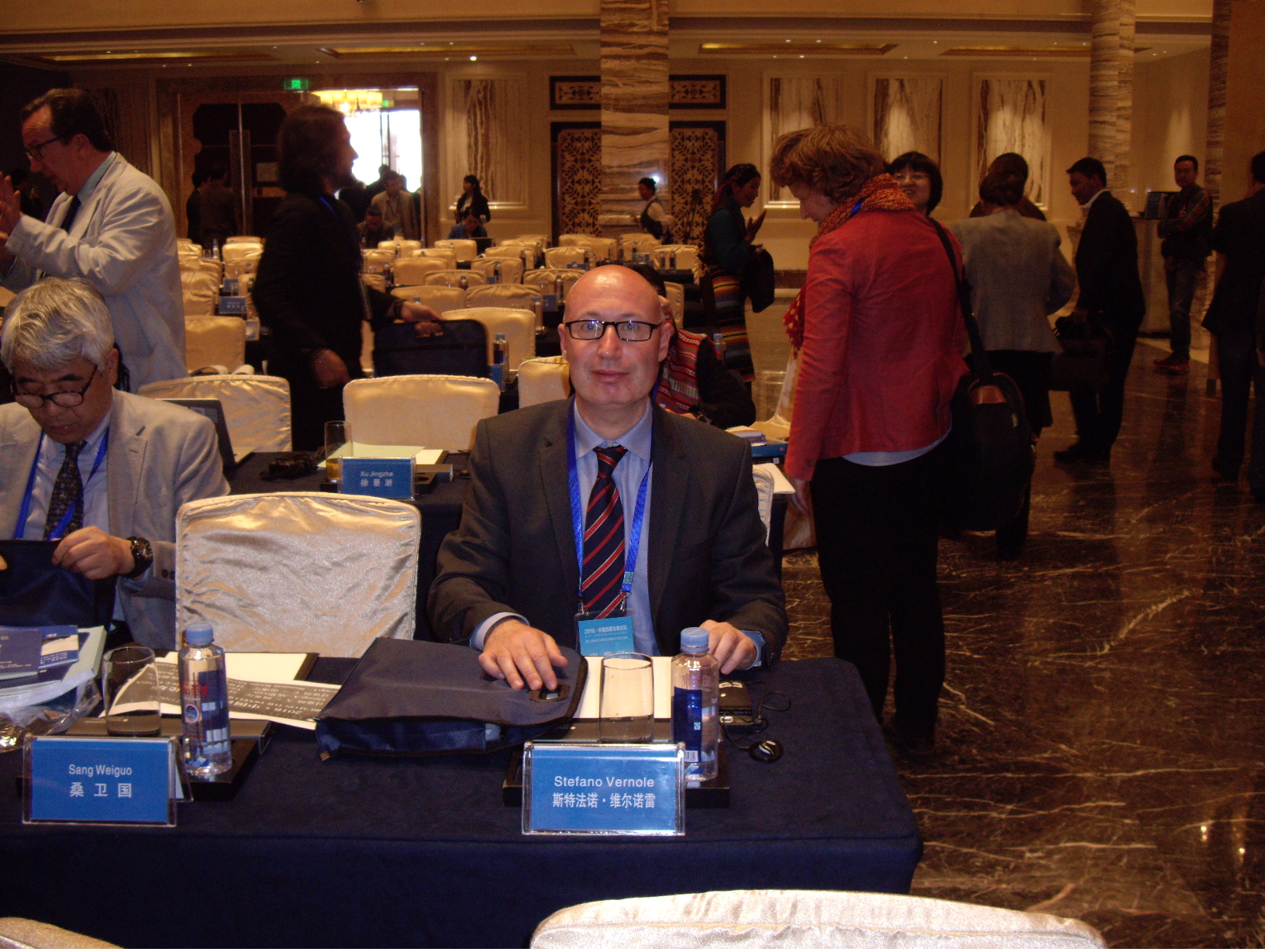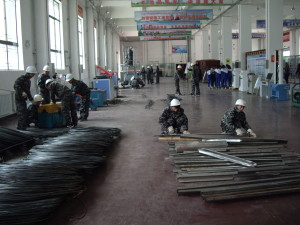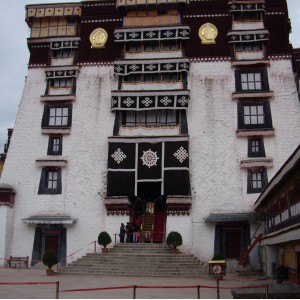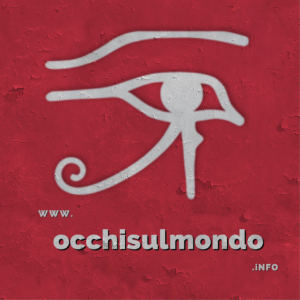Lo sviluppo del Tibet/Xizang e la Nuova Via della Seta
di Stefano Vernole
Introduzione
Il Tibet, regione autonoma della Repubblica Popolare Cinese, si trova nella parte meridionale dell’altopiano Qinghai-Tibet, al confine sud-ovest della Cina.
Lo Xizang è stato parte integrante della Cina fin dai tempi antichi ma prima del 1950 era una società di servitù feudale, dominata da un governo teocratico attraverso una combinazione di poteri politici e religiosi.
I funzionari di governo, gli aristocratici e i monasteri mantenevano di comune accordo uno stretto controllo sulle risorse e le ricchezze del Tibet, mentre il popolo tibetano viveva una situazione di miseria terribile, senza alcuna libertà.
La fondazione della Repubblica Popolare Cinese nel 1949 ha segnato l’ingresso del Tibet nella civiltà moderna.
Dopo una serie di importanti tappe storiche, dalla sua liberazione pacifica alle riforme democratiche per la costituzione della regione autonoma e l’apertura al mondo esterno, il Tibet è stato mantenuto nella stessa corsia di sviluppo del resto della Cina.
I punti principali della strategia economica sono stati fondamentalmente quattro: 1) la stipulazione di accordi paritari e di mutuo vantaggio con i Paesi limitrofi sulla base dei “cinque principi della coesistenza pacifica”, che hanno posto fine allo stato semi-coloniale del Tibet; 2) la costruzione delle strade Kang-Tibet e Qinghai-Tibet e dell’aeroporto Dangxiong, che hanno implementato i trasporti e rafforzato i collegamenti tra Lhasa e Pechino; 3) la costruzione di fabbriche e fattorie sintetiche dotate di moderni impianti industriali, banche, società commerciali, uffici postali … per favorire lo sviluppo industriale e commerciale del Tibet; 4) l’introduzione di avanzate tecnologie di coltivazione tramite il dissodamento dei terreni deserti e la costruzione di fattorie, la concessione di crediti a fondo perduto per l’agricoltura, l’allevamento e l’artigianato che ne hanno consentito il decollo economico.
Mezzo secolo dopo, il Tibet è un mondo completamente diverso da quello che era prima degli anni ’50; il popolo tibetano ha guadagnato la libertà, l’uguaglianza, la dignità e gode completamente dei frutti della civiltà moderna.
Lo sviluppo ed il progresso della regione riflettono le aspirazioni comuni di tutti i gruppi etnici in Tibet – oltre ai tibetani, almeno una dozzina – Han, Hui, Moinba, Lhoba, Naxi, Nu, Drung e altri.
Pietre miliari dello sviluppo del Tibet e il suo progresso
La fondazione della Repubblica Popolare Cinese nel 1949 ha aperto nuove prospettive per lo sviluppo e il progresso della nazione ad un livello senza precedenti.
Nel 1951 il Governo centrale di Pechino e quello tibetano locale hanno firmato l’accordo sulle misure per la liberazione pacifica del Tibet, come simbolo dell’integrazione nel resto della Cina.
Il 1959 ha però segnato una svolta nella sua storia, i tibetani hanno esercitato attivamente il diritto di voto e di eleggibilità conferitogli dalla Costituzione, hanno partecipato a tutti i livelli all’elezione dei deputati del Congresso Nazionale del Popolo (NPC) e successivamente (1965) alla gestione degli affari locali della Regione Autonoma del Tibet.
In quell’anno il ceto dirigente superiore e reazionario del Tibet non è riuscito, nonostante una ribellione armata, a perpetuare il proprio status favorevole di servitù feudale e il Governo centrale ha annunciato pubblicamente il licenziamento del Governo locale tibetano.
Nel frattempo persone appartenenti a tutti i gruppi etnici presenti in Tibet hanno lanciato un’ampia riforma democratica per rovesciare il sistema di servitù feudale in vigore sotto la teocrazia lamaista da centinaia di anni, inaugurando una riforma sociale che è stata considerato la più estesa, profonda e progressiva della storia tibetana.
Le terre e i beni dei proprietari latitanti o detenuti vennero ridistribuiti ai contadini e ai pastori, i possidenti che non erano stati coinvolti nella ribellione poterono mantenere la proprietà di un lotto di terreno e di altri mezzi di produzione.
Nel 1965 è stata fondata la Regione Autonoma del Tibet e sono stati istituiti sistemi di Congresso del popolo insieme all’autonomia regionale etnica; il Congresso della Regione Autonoma ha emanato 220 regolamenti locali o separati, relativi agli aspetti economici, culturali, educativi, ambientali … incluse alcune Risoluzioni per la lotta alle attività separatiste.
Con l’istituzione del nuovo sistema politico e la diffusione di idee sulla politica di autogestione, gli ex servi e schiavi (cioè il 95% della popolazione), nonché gli aristocratici feudali sono divenuti tutti cittadini moderni che godono di pari diritti, possono esercitare in maniera autonoma i diritti politici di partecipazione sia nella gestione degli affari di Stato sia in quella degli affari dei gruppi etnici locali.
L’organo di autogoverno ha designato il Capodanno tibetano, il Shoton festival e altre manifestazioni tradizionali come giorni festivi ufficiali della Regione Autonoma, ha fissato la settimana lavorativa a 35 ore, ha abbassato di due anni l’età del matrimonio legale per uomini e donne inaugurato altre riforme.
Alla fine del 1978, il Tibet ha avviato la riforma e l’apertura verso la modernizzazione insieme al resto del Paese, inaugurando una nuova fase di sviluppo economico e sociale.
Il Governo centrale ha fissato obiettivi elevati per il Tibet, cercando di accelerare il suo sviluppo e avanzare nella prima fila delle “quattro modernizzazioni”, consentendo alle famiglie di “utilizzare e gestire a lungo termine e in modo indipendente la terra, la proprietà, l’allevamento e la gestione del bestiame da parte dei singoli nuclei familiari”.
Alla luce delle condizioni locali, il Governo di Pechino ha sancito nel 1994 dei principi guida per il lavoro in Tibet e ha emesso delle direttive politiche favorevoli per la Regione autonoma che ne hanno energicamente contribuito al miglioramento del tenore di vita e al progresso.
Al quinto simposio sul lavoro, tenutosi nel gennaio 2010, le Autorità centrali cinesi hanno impostato gli obiettivi per lo sviluppo del Tibet nella fase successiva.
Quelli raggiunti nel 2015 hanno mantenuto forte il ritmo dello sviluppo economico, ridotto in modo significativo il divario tra il reddito pro capite degli agricoltori e dei pastori rispetto alla media nazionale, aumentato significativamente la capacità del Tibet di fornire servizi pubblici, migliorare ulteriormente l’ecosistema, sviluppare ulteriormente le infrastrutture del Tibet, raggiungere l’unità e l’armonia tra tutti i gruppi etnici, mantenere la stabilità sociale e garantire un più solido fondamento per la costruzione di una società moderatamente prospera sotto tutti gli aspetti.
Il prodotto interno lordo regionale (GRP) del Tibet è salito vertiginosamente dai 129 milioni di yuan del 1.951 ai 70 miliardi e 100 milioni di yuan nel 2012, che rappresentano mediamente una crescita annua del 8,5 per cento.
Il PIL pro capite ha raggiunto i 22.900 yuan.
Dal 1994-1995, anno in cui sono state stabilite le basi fondamentali per un’economia di mercato socialista, il Tibet ha addirittura realizzato una crescita a due cifre per 19 anni consecutivi, con un tasso di crescita annuo del 12,7% in media.
Il reddito pro capite netto degli agricoltori e dei pastori in Tibet ha mantenuto una crescita a due cifre per 10 anni consecutivi, raggiungendo 5.719 yuan nel 2012.
Il reddito pro capite disponibile degli abitanti delle città, nello stesso anno, è stato di 18.028 yuan.
L’avvio di una nuova campagna socialista, iniziata nel 2006, ha recato grande beneficio agli agricoltori e ai pastori locali, soprattutto attraverso i suoi progetti di edilizia a basso reddito.
Alla fine del 2012 erano state costruite un totale di 408.300 case a basso reddito, che hanno fornito alloggio all’ 88,7% delle famiglie locali di agricoltori e pastori; queste categorie si sono trasferite in case moderne e sicure alla fine del 2013.
Nel 2012, lo spazio pro capite di agricoltori e pastori era 28.77 mq, mentre quello degli abitanti urbani 36.14; da rilevare che agricoltori e pastori ricevono cure mediche gratuite e i loro figli frequentano la scuola senza oneri di vitto e alloggio.
Nelle zone rurali, le infrastrutture sono state migliorate per fornire i servizi necessari alla popolazione locale, compresa l’acqua, l’energia, i trasporti, le telecomunicazioni, il gas naturale, la radio, la televisione, e i servizi postali.
Circa il 90% e il 99,7% dei Comuni tibetani hanno accesso ai servizi postali e alla rete stradale, il 94,2% dei villaggi amministrativi possono essere raggiunti su strada.
Un totale di 1,93 milioni di agricoltori e pastori riceve acqua potabile sicura, 150.000 famiglie rurali stanno utilizzando biogas pulito, oltre il 95% delle famiglie rurali utilizza sale iodato.
Mentre la vita migliora, le persone iniziano ad avere più scelte tra i beni di consumo: frigoriferi, televisori a colori, telefono, computer, lavatrici, motocicli, telefoni cellulari e altri beni di consumo sono entrati far parte della vita delle famiglie ordinarie.
Secondo “Vita Survey”, trasmissione nazionale condotta congiuntamente dal National Bureau of Statistics, Post Group Cina e China Central Television (CCTV), Lhasa si trova in cima agli “indici di felicità” da cinque anni consecutivi.
Uno sviluppo impetuoso ma sostenibile
Mettendo al primo posto gli interessi del popolo e ricercando uno sviluppo ecologicamente sostenibile, il Tibet ha adottato misure rigorose per la limitazione dell’inquinamento energetico esteso e delle alte emissioni industriali inquinanti.
Nel suo territorio le risorse forestali coprono un’estensione pari all’11,31%, sono presenti più di 80 milioni di prateria e 200.000 ettari di terra arabile privi di inquinamento industriale, 1.600 laghi dell’altopiano tibetano si trovano allo stato primordiale e incontaminato: complessivamente, le riserve naturali interessano circa il 40% dell’intero territorio tibetano.
Integrando il progresso socio-economico e la tutela dell’ambiente, il Tibet si sforza di tutelare gli interessi a lungo termine della sua gente.
Nel villaggio di Chek Kang (contea di Sangri), che si trova nella zona sud orientale del paese, è stata costruita la centrale solare più alta del mondo (si trova a 4.000 metri di altitudine), con una potenza di 10 MW è in grado di fornire per i prossimi 20 anni energia pulita a migliaia di tibetani.
Suntech Power, realizzatore della centrale, ha già impiantato in Tibet l’impianto fotovoltaico che fornisce energia agli alpinisti nel campo base dell’Everest, oltre a numerosi impianti isolati e donati a scuole, abitazioni … essa rappresenta un’interessante opzione per ridurre i rischi di crisi energetica e diversificare il sistema di approvvigionamento.
Stazioni di energia idroelettrica sono distribuite in tutta la Regione, la più famosa è la centrale geotermica di Yangbajain che fornisce energia pulita alle famiglie tibetane 24 ore su 24: grazie all’avvio del programma “luce del sole”, il Tibet è l’area più avanzata per l’utilizzo di energia solare in tutta la Cina.
Ora grazie ad una delega gestionale a livelli più bassi, l’annullamento della vecchia tassa agricola, l’aumento di capitale e gli investimenti tecnici che stanno promuovendo la produttività complessiva, il Tibet ha realizzato uno sviluppo equilibrato e sostenibile in agricoltura e in zootecnia.
La produzione di grano annuale negli ultimi anni resta al di sopra delle 900.000 tonnellate e il valore aggiunto della sua industria primaria è aumentato dai 128 milioni di yuan del 1959 agli 8 miliardi e 38 milioni di yuan nel 2012, una crescita del 4,7% ogni anno.
Oggi il Tibet possiede un sistema industriale moderno che comprende più di 20 settori industriali, tra i quali l’energia, l’industria leggera, tessile, i macchinari, l’industria mineraria, materiali da costruzione, l’industria chimica, alimentare, l’artigianato popolare e la medicina tradizionale tibetana (nel 1989 vennero fondati l’Università e il Collegio di medicina tibetana, la più grande scuola al mondo specializzata in medicina e farmacia tibetane).
Il valore totale della produzione industriale è salito alle stelle da 1,4 milioni di yuan nel 1.956 ai 10 miliardi e 591 milioni di yuan nel 2012, fino ai 18,28 miliardi di yuan del 2013.
Le principali industrie con caratteristiche locali sono in espansione e godono di favorevoli economie di scala, il terziario è in rapida crescita.
Nel 2012, il Tibet ha accolto turisti nazionali e stranieri per un totale di 10 milioni 584.000 visitatori, (191.000 i turisti stranieri) ed un fatturato di 12.650 milioni di yuan, nel 2013 e 2014 il numero di visitatori sfiora i 13 milioni.
L’antico Tibet non aveva strade in senso moderno, ma detiene oggi un sistema di trasporto globale che include strade, aerei, ferrovie ed un trasporto con tubazioni notevolmente sviluppato e migliorato.
Nel 2012 il Tibet è attraversato da 8.896 km di strade con superficie sub-alto grado o superiore e la lunghezza totale delle strade aperte al traffico ha raggiunto i 65.200 chilometri.
Ogni provincia e borgata ha accesso al trasporto su strada, 62 contee sono raggiungibili da strade asfaltate, sono state costruite 15 tra autostrade e superstrade per un totale di 22.500 chilometri.
Nel 2006 con la la Qinghai-Tibet Railway (la ferrovia più alta del mondo) iniziò l’introduzione del trasporto ferroviario in Tibet e dopo una serie straordinaria di opere nel 2014 la costruzione della linea di treni che collega Lhasa e Shigatse è stata completata con successo.
L’autostrada asfaltata Qinghai-Tibet, lunga 2.122 km., è conosciuta come la linea vitale dei trasporti su strada, in quanto l’80% delle merci che arrivano in Tibet passano di qui; l’altra autostrada, quella del Sichuan, ha due diramazioni: a nord, da Chengdu a Lhasa attraverso Gangtong e Qamdo corre per 2.415 km., a sud, da Chengdu a Lhasa attraverso Zogang e Bangda per 2.136 km., rappresenta il mezzo principale per collegare il Tibet alle altre province della Cina sud-occidentale.
Oggi 34 rotte aeree nazionali collegano il Tibet con altre parti della Cina, con il Gonggar Airport (Lhasa) come terminale principale completato da Banda Airport (Qamdo), Mailing Airport (Nyingchi), Gunsa Airport (Ngari), Heping Airport (Shigatse).
Attualmente il settore energetico della regione conosce una rapida crescita; con l’alimentazione idraulica come fonte principale di energia, il Tibet sta sviluppando anche l’energia geotermica, l’energia eolica, l’energia solare e altre energie nuove che si completano a vicenda.
Nel 2012 la capacità totale dei generatori installati ha raggiunto 1,23 milioni kw e la copertura di alimentazione è stata del 100%.
Attualmente una rete di cavo ottico, satellitare e di linee telefoniche a lunga distanza è stata stabilita nella regione e tutti i luoghi a livello di contea sono coperti da segnali 3G.
Ogni borgata possiede una connessione a banda larga e ogni villaggio gode di servizi telefonici; nel 2012 il numero di famiglie che utilizzano il telefono fisso ha raggiunto la cifra di 2.760.000, 91 telefoni ogni 100 persone.
Nel medesimo anno il numero di famiglie con utenti e connessioni internet era pari a 1,47 milioni, con un tasso di copertura del 33,3%.
La mortalità infantile è scesa da 430 morti ogni 1.000 nati a 6-25 morti ogni mille nascite nel 2012; tra il 2003 e il 2008, 25 miliardi di yuan governativi sono stati investiti nell’istruzione, nelle strutture scolastiche e per incrementare i tassi di alfabetizzazione.
Le iscrizioni alle scuole elementari e medie hanno raggiunto rispettivamente il 98,5% e il 92,2% delle classi di età di riferimento, dalla fondazione dell’Istituto delle nazionalità del Tibet (1965) ad oggi si sono registrati 30.000 laureati.
Tutti gli studenti tibetani sono tenuti ad imparare la lingua tibetana nel corso dei 9 anni di istruzione obbligatoria, molti libri e riviste sono scritti nella loro lingua e questo consente di tutelarne la cultura e i diritti durante le controversie giudiziarie (i documenti legali vengono scritti in tibetano).
Il 70,42% dei pubblici ufficiali della Regione, a tutti i livelli, è costituito da tibetani e da appartenenti ad altre minoranze etniche, in 74 contee, città, prefetture e in 682 Comuni la percentuale sale all’86%.
Nel 2012 il volume totale del suo commercio estero ha raggiunto 3,424 miliardi dollari, più di 850 volte quello del 1953 che si attestava a 4 milioni di dollari, con un tasso di crescita annuo del 12,1%.
Alla fine del 2012 gli investimenti esteri registrati in Tibet sono stati di 470 milioni di dollari e approfittando della sua posizione geografica, Lhasa sta rafforzando la cooperazione amichevole con l’India, il Nepal e gli altri paesi vicini.
In particolare, per promuovere il commercio di confine, si sta costruendo una strada di passaggio per l’Asia meridionale via terra, insieme a centri commerciali in città portuali come Gyirong, Zhangmu, Yatung, Pulan e Riwu.
Oggi ci sono 23.085 insegnanti bilingue e 3.700 insegnanti di lingua tibetana nelle scuole a diversi livelli.
La lingua tibetana è ampiamente utilizzata nella vita politica; risoluzioni, leggi e regolamenti adottati nei congressi del popolo, documenti formali e dichiarazioni pubblicate dai governi ai vari livelli e per i loro servizi sussidiari sono scritti sia in tibetano che in cinese.
Nei procedimenti giudiziari, la lingua tibetana viene adottata per dirimere le questioni attinenti al gruppo etnico tibetano ed è utilizzata nei documenti legali scritti.
Sia il tibetano che il cinese compaiono nei sigilli ufficiali, per le credenziali e i certificati, per i moduli, le buste e la carta da lettere, per gli identificatori, nei segnali delle unità lavorative, nelle fabbriche e nelle miniere, in scuole, stazioni, aeroporti, negozi, alberghi, ristoranti, teatri, macchine, impianti sportivi, biblioteche, segnali stradali e di regolamentazione del traffico.
Ci sono 14 riviste e dieci giornali in lingua tibetana in Tibet, “Radio Tibet popolare” vanta 42 programmi e colonne (compresi i Khampa); il suo canale di notizie in lingua tibetana trasmette 21 ore al giorno e il suo canale Khampa per 18 ore al giorno.
La stazione “TV Tibet” ha un canale che trasmette in lingua tibetana 24 ore al giorno, mentre nel solo 2012 sono stati pubblicati nella Regione autonoma del Tibet 780 libri, per un totale di 4,31 milioni di copie.
I computer codificano i caratteri tibetani che hanno raggiunto gli standard nazionali e internazionali, l’editing tibetano, la fotocomposizione laser e l’editoria elettronica, sviluppate in maniera indipendente dalla Cina, vengono ampiamente applicate.
Attraverso Internet, i telefoni cellulari e altri mezzi mobili, i tibetani possono leggere, ascoltare e guardare le notizie nazionali e internazionali e ottenere tutti i tipi di informazioni utili alla loro vita quotidiana.
Pur mantenendo e sviluppando la lingua tibetana, lo Stato diffonde anche il cinese standard in tutto il paese, comprese le regioni abitate dalle minoranze etniche.
Nel 2014 sono state aumentate le pensioni mensili da 302 a 3.006 yuan, la soglia più alta della Cina, insieme all’adeguamento del reddito minimo e alle nuove forniture di cibo e indumenti per le famiglie bisognose, inoltre 2 milioni di yuan in 3 anni (2014-2016) sono stati destinati alle adozioni e al mantenimento dei bambini orfani.
Ovviamente questi risultati non sarebbero stati possibili senza il supporto del Governo centrale e il contributo delle regioni più sviluppate, sussidi finanziari calcolabili in 54,8 bilioni di yuan; dal 2011 al 2015, Pechino ha previsto di completare 226 dei maggiori progetti per il miglioramento del benessere generale, la costruzione di infrastrutture, industrie e per lo sviluppo ambientale, un totale di investimenti pari a 193,1 bilioni di yuan, 71,5 dei quali erogati direttamente.
Il numero di persone che hanno partecipato al programma di base per gli impiegati nelle varie imprese, al programma di sicurezza sociale per i residenti urbani, al nuovo programma di dotazione assicurativa per quanti lavorano nelle aree rurali, ai programmi pensionistici, agli assegni di disoccupazione e di maternità ammontano rispettivamente a: 138.300, 74.400 (inclusi 24.600 tra lama e monaci), 1,3054 milioni, 145.500, 117.000 e 184.600.
Le spese totali per la sicurezza sociale della Regione nel 2013 sono state di 7,798 bilioni di yuan (una crescita del 25,5% rispetto al 2012), i lavoratori urbani e i residenti che hanno aderito ai programmi di assicurazione sanitaria ammontano rispettivamente a 283.000 e 240.700; i primi hanno ricevuto contributi per 192,197 milioni di yuan mentre quelli delle zone rurali per 281,477 milioni di yuan, con un’offerta costituita da 263 istituzioni di assistenza sociale (ad es. centri per la cura dei bambini …).
Questa programmazione ha consentito di aumentare le entrate fiscali del Tibet/Xizang, che alla fine del 2013 avevano raggiunto la cifra di 11,04 bilioni di yuan, con un incremento del 15,04% rispetto al 2012, mentre il totale delle spese fiscali è stato di 104,713 bilioni di yuan (il 12,6% in più).
La spesa per l’impiego e la sicurezza sociale è cresciuta a 7,798 bilioni di yuan (+ 25,5%), per l’educazione 10,915 bilioni di yuan (+ 19%), per l’assistenza sanitaria 3,93 bilioni di yuan (+ 9,8%) e per la protezione ambientale 1,769 bilioni di yuan (- 24,5%): il Governo centrale ha aumentato i sussidi di oltre 90 bilioni di yuan.
L’investimento in beni tangibili nel 2013 è stato di 91,848 bilioni di yuan, un aumento del 29,4% rispetto al 2012, il maggiore tasso di crescita della Cina, quello nell’industria primaria è stato di 4,86 bilioni di yuan (+ 51,7%), mentre nell’industria secondaria di 28,632 bilioni di yuan (+28,5%), nell’industria terziaria di 58,357 bilioni di yuan (+ 28,2%).
Nello stesso anno il settore immobiliare ha registrato investimenti per 968 milioni di yuan, più 40,8% rispetto all’anno precedente, lo spazio destinato agli edifici in costruzione ha raggiunto un totale di 577.000 metri quadrati (+ 21,9% rispetto al 2012).
Attualmente, il Tibet possiede 4.277 siti culturali (tra cui 55 quelli a livello statale e 210 quelli regionali), e 2.320.000 reperti tratti da questi siti vengono conservati nella collezione nazionale.
Il Palazzo Potala, il tempio di Jokhang Norbulingka si trovano nella Lista del Patrimonio Mondiale dell’Umanità, Lhasa, Shigatse e Gyangtse sono state elevate a livello di sito storico e città d’arte, il Museo del Tibet a livello nazionale.
Dal 2000 il Governo centrale di Pechino ha investito 2,04 miliardi di yuan in progetti chiave per la conservazione e la manutenzione dei beni culturali in Tibet, tra questi più di 380 milioni di yuan sono stati utilizzati nei tre progetti chiave del Palazzo Potala, Norbulingka e Monastero Sakya.
Il Governo popolare della Regione Autonoma del Tibet ha reso lo sviluppo della medicina tradizionale tibetana una componente fondamentale della sua strategia di assistenza sanitaria.
Mentre Stati Uniti ed Unione Europea vorrebbero varare un contestato “Accordo di Partnership sul Commercio e gli Investimenti” (TTIP), il grande progetto cinese della Nuova Via della Seta terrestre si consolida sempre di più.
Si tratta di una grandiosa iniziativa che intende connettere la Cina con l’Europa occidentale lungo una linea ferroviaria di 2.500 chilometri attraverso il Kazakhstan; collegando inoltre Cina, Europa, Turchia e Medio Oriente, essa creerà un corridoio economico che favorirà la stabilità e la sicurezza energetica, oltre a ridurre drasticamente il tempo di trasporto delle merci.
Ispirandosi alla visione geopolitica della dinastia Tang (618-907) e ai sei corridoi dell’antica Via della Seta, il Presidente Xi Jinping ha riconosciuto la centralità della propria regione del Tibet/Xizang, che è attraversata sia dai corridoi economici che legano la Cina attraverso il Myanmar e attraverso il Pakistan all’Oceano Indiano, sia ai corridoi economici che attraversano l’Asia centrale e collegano la Cina all’Iran, alla Turchia e al Medio Oriente.
Il Tibet, il cui altopiano ricoperto da 46.000 ghiacciai rappresenta il luogo di nascita dei maggiori fiumi asiatici come il Mekong, lo Yangtze, l’Indo e il Brahmaputra, fu ritenuto inaccessibile per molti anni, affascinò generazioni di viaggiatori e fece sognare i circoli esoterici del Pianeta.
Tra Cina e Nepal è stata sottoscritta un’intesa che prevede la formazione di un corridoio economico per i beni prodotti dal Dragone che devono giungere fino all’India, insieme alla costruzione di una linea ferroviaria che unisca i due Paesi.
Il Governo cinese vuole potenziare la tratta che unisce la sua provincia del Qinghai alla regione autonoma del Tibet, così da collegarle al Nepal e all’Asia meridionale; attualmente da Lhasa il treno arriva fino a Shigatse, a 253 chilometri dal confine nepalese, ma con l’assenso del Governo di Kathmandu nasceranno presto altre due linee: una fino a Rasuwagadhi e l’altra fino a Yadong sul confine indo-bhutanese.
Secondo il Ministro degli Esteri di Pechino, Wang Yi, dovrebbe far parte dell’accordo anche Nuova Delhi, realizzando un’intesa trilaterale di alto valore simbolico.
The development of Tibet / Xizang and New Silk Road
Stefano Vernole
Introduction
The Tibet Autonomous Region of the People’s Republic of China, is located in the southern part of the Qinghai-Tibet, to the southwest border of China.
The Xizang has been part of China since ancient times, but before 1950 was a feudal serfdom society, dominated by a theocratic government through a combination of political and religious powers.
Government officials, aristocrats and the monasteries maintained by mutual agreement a tight grip on the resources and riches of Tibet, and the Tibetan people lived a terrible situation of misery, without any freedom.
The founding of the People’s Republic in 1949 marked the entrance of Tibet in modern civilization.
After a series of important historical milestones, from its peaceful liberation to democratic reforms for the establishment of the autonomous region and the opening to the outside world, Tibet has been kept in the same lane of development of the rest of China.
The main points of the economic strategy were basically four: 1) the stipulation of equal and mutual benefit agreements with neighboring countries based on the “Five Principles of Peaceful Coexistence”, which ended in the semi-colonial Tibet; 2) the construction of roads Kang-Tibet and Qinghai-Tibet and airport Dangxiong, who have implemented transportation and strengthened the links between Lhasa and Beijing; 3) the construction of factories and synthetic farms equipped with modern industrial plants, banks, trading companies, post offices … to promote industrial and commercial development of Tibet; 4) the introduction of advanced farming technologies through the clearing of the desert land and the construction of farms, the granting of credit grant for agriculture, livestock and crafts that have allowed the economic take-off.
Half a century later, Tibet is a world completely different from what it was before the ’50s; the Tibetan people have gained freedom, equality, dignity and fully enjoy the fruits of modern civilization.
The development and progress of the region reflect the common aspirations of all ethnic groups in Tibet – in addition to the Tibetans, at least a dozen – the Han, Hui, Moinba, Lhoba, Naxi, Nu, Drung and others.
Milestones in the development of Tibet and its progress
The founding of the People’s Republic in 1949 has opened up new prospects for the development and progress of the nation to an unprecedented level.
In 1951 the central government in Beijing and the Tibetan local have signed the Agreement on Measures for the Peaceful Liberation of Tibet, as symbol of integration in the rest of China.
The 1959, however, marked a turning point in its history, Tibetans have actively exercised the right to vote and stand for election bestowed by the Constitution, they have participated at all levels of the election of deputies of the National People’s Congress (NPC) and later (1965) at the administration of the Tibet Autonomous Region local affairs.
In that year, the upper ruling strata and reactionary of Tibet is unable, despite an armed rebellion, to perpetuate their status in favor of feudal serfdom and the central government has publicly announced the dismissal of the local Tibetan government.
Meanwhile people from all ethnic groups in Tibet have launched a wide democratic reform to overthrow the feudal serfdom system in place under the Lamaist theocracy for hundreds of years, ushering in a social reform that has been considered the most extensive, profound and progressive of Tibetan history.
The lands and the assets of fugitives owners or detainees were redistributed to peasants and shepherds, the landowners who had not been involved in the rebellion were able to retain ownership of a plot of land and other means of production.
In 1965 it was founded the Tibet Autonomous Region and were set up systems of Congress of the people along ethnic regional autonomy; Congress of the Autonomous Region has enacted 220 local or separate regulations, relating to the economic, cultural, educational, environmental … including some Resolutions combating separatist activities.
With the establishment of the new political system and the spread of ideas about self-management policy, the former serfs and slaves (that is 95% of the population), as well as the feudal aristocrats have all become modern citizens who enjoy equal rights, they can exercise in independently the political rights of participation in the management of state affairs both in the business of local ethnic groups.
The self-governing body has designated the Tibetan New Year, the Shoton festivals and other traditional events as official holidays of the Autonomous Region, has fixed the work week to 35 hours, lowered by two years the legal age of marriage for men and women launched other reforms.
At the end of 1978, Tibet has initiated the reform and opening toward modernization along with the rest of the country, ushering in a new phase of economic and social development.
The central government has set high goals for Tibet, trying to accelerate its development and advance in the first row of the “four modernizations”, allowing families to use and maintain long-term and independently the land, the property, the breeding and livestock management by individual households.
In the light of local conditions, the Beijing government has sanctioned in 1994 the guiding principles for the work in Tibet and has issued favorable policies guidelines for the Autonomous Region who have contributed strongly to the improvement of living standards and progress.
The fifth symposium on the work, which took place in January 2010, the Chinese central authorities have set targets for the development of Tibet in the next step.
Those achieved in 2015 have maintained the strong pace of economic development, significantly reduced the gap between the per capita income of farmers and herdsmen than the national average, significantly increased Tibet’s ability to provide public services, further improve the ecosystem , further develop the infrastructure of Tibet, achieve unity and harmony among all ethnic groups, maintain social stability and ensure a solid foundation for building a moderately prosperous society in all respects.
The Gross Regional Product (GRP) of Tibet has soared from 129 million yuan of 1951 to 70 billion and 100 million yuan in 2012, which represents an average annual growth of 8.5 percent.
GDP per capita reached 22,900 yuan.
From 1994-1995, the year in which they were established the fundamental basis for a socialist market economy, Tibet has even built a double-digit growth for 19 consecutive years, with an annual growth rate of 12.7% on average .
The per capita net income of farmers and herdsmen in Tibet has maintained a double-digit growth for 10 consecutive years, reaching 5,719 yuan in 2012.
The per capita disposable income of urban residents, the same year was 18,028 yuan.
The start of a new socialist countryside, which began in 2006, has brought great benefit to farmers and local pastors, especially through its low-income housing projects.
At the end of 2012 they were built a total of 408,300 low-income homes, who have provided lodging to 88.7% of the local families of farmers and herders; these categories have moved to modern houses and safe at the end of 2013.
In 2012, the per capita space of farmers and shepherds was 28.77 square meters (sq. m.), while that of urban dwellers 36.14; it is pointed out that farmers and herdsmen receive free medical care and their children attend school without room and board charges.
In rural areas, the infrastructure has been improved to provide the necessary services to the local population, including water, energy, transport, telecommunications, natural gas, radio, television, and postal services.
About 90% and 99.7% of the towns Tibetans have access to postal services and the road network, 94.2% of administrative villages can be reached by road.
A total of 1.93 million farmers and herdsmen receive safe drinking water, 150,000 rural households are using clean biogas, more than 95% of rural households using iodized salt.
As life improves, people start to have more choices among consumer goods: refrigerators, color televisions, phones, computers, washing machines, motorcycles, mobile phones and other consumer goods have come to be part of the lives of ordinary families.
According to “Life Survey”, a national program hosted jointly by the National Bureau of Statistics, China Post Group and China Central Television (CCTV), Lhasa is located on top of the “happiness index” for five consecutive years.
Is rapid growth, but sustainable
By prioritizing the interests of the people and seeking ecologically sustainable development, Tibet has taken vigorous measures to limit pollution extended energy and high polluting industrial emissions.
In its territory forest resources covering an extension of all’11,31%, there are more than 80 million hectares of grassland and 200,000 arable land free from industrial pollution, 1,600 Tibetan plateau lakes are the primordial and pristine condition : overall, the nature reserves cover about 40% of the entire Tibetan territory.
Integrating socio-economic progress and environmental protection, Tibet strives to protect the long-term interests of its people.
In the village of Chek Kang (Sangri County), located in the south east of the country, the world’s highest solar power station was built (it is located at 4,000 meters above sea level), with a capacity of 10 MW is able to provide for the next 20 years clean energy to thousands of Tibetans.
Suntech Power, scorer of the center, has already implanted the photovoltaic system in Tibet that provides power to the climbers in the Everest base camp, as well as numerous isolated systems and donated to schools, housing … it is an interesting option to reduce the risks of the energy crisis and diversify the supply system.
Hydropower stations are distributed throughout the region, the most famous is the Yangbajain geothermal power plant that provides clean energy to Tibetan families 24 hours on 24: thanks to the start of the program “sunlight”, Tibet is the area more advanced for the use of solar energy throughout China.
Now thanks to a management powers to lower levels, the cancellation of the old agricultural tax, the increase in capital and capital expenditures that are promoting overall productivity, Tibet has achieved a balanced and sustainable development in agriculture and animal husbandry.
The annual wheat production in recent years remains above the 900,000 tons, and the added value of its primary industry increased from 128 million yuan in 1959 to 8 billion and 38 billion yuan in 2012, an increase of 4.7% every year.
Today Tibet has a modern industrial system that includes more than 20 industries, including energy, light industry, textile, machinery, mining, building materials, chemical industry, food, folk handicrafts and Tibetan medicine (in 1989 were founded the University and the College of Tibetan medicine, the largest school in the world specializing in Tibetan medicine and pharmacy).
The total industrial output value has skyrocketed from 1.4 million yuan in 1956 to 10 billion and 591 million yuan in 2012, up to 18.28 billion yuan in 2013.
The main industries with local characteristics are expanding and enjoy favorable economies of scale, the service sector is growing rapidly.
In 2012, Tibet has received domestic and foreign tourists for a total of 10 million 584,000 visitors (191,000 foreign tourists) and a revenue of 12.65 billion yuan, in 2013 and 2014 the number of visitors touch on 13 million.
The old Tibet had no roads in the modern sense, but now holds a global transportation system including roads, air, rail and pipeline transport with greatly developed and improved.
In 2012 Tibet is crossed by 8,896 km of roads with sub-surface high-grade or higher and the total length of roads open to traffic reached 65,200 kilometers.
Each county and township has access to the road transport, 62 counties are accessible by paved roads, they were built between 15 motorways and expressways with a total of 22,500 kilometers.
In 2006 with the Qinghai-Tibet Railway (the highest railroad in the world) began the introduction of railway transport in Tibet and after an extraordinary series of works in 2014 the construction of the train line linking Lhasa and Shigatse has been completed with success.
The paved highway Qinghai-Tibet, long 2122 km., is known as the lifeline of road transport, because 80% of goods entering Tibet pass through here; the other highway, that of Sichuan, has two branches: to the north, from Chengdu to Lhasa and Qamdo through Gangtong runs for 2415 km., to the south, from Chengdu to Lhasa and Bangda Zogang through to 2136 km., is the primary means to link Tibet to the other provinces of southwestern China.
Today 34 domestic air routes linking Tibet with other parts of China, with the Gonggar Airport (Lhasa) as the main terminal completed by Banda Airport (Qamdo), Mailing Airport (Nyingchi), Gunsa Airport (Ngari), Heping Airport (Shigatse).
Currently the energy sector of the region has grown rapidly; with the water supply as the main source of energy, Tibet is also developing geothermal energy, wind energy, solar energy and other new energies that complement each other.
In 2012, the total capacity of installed generators has reached 1.23 million kw, and the power coverage was 100%.
Currently an optical cable network, satellite and long-distance telephone lines has been established in the region and all the places at the county level are covered by 3G signals.
Each township has a broadband connection, and every village has telephone services; in 2012 the number of households that use the desk phone has reached the figure of 2,760,000, 91 phones every 100 people.
In the same year the number of households with Internet connections and users amounted to 1.47 million, with a coverage rate of 33.3%.
Infant mortality has fallen from 430 deaths every 1,000 births in 6-25 deaths every thousand births in 2012; between 2003 and 2008, 25 billion yuan of government were invested in education, provide education and increase literacy rates.
Enrolment in elementary and middle schools reached 98.5% and 92.2% of the classes of reference age, from the foundation of the nationalities of Tibet (1965) to date there have been 30,000 graduates.
All the Tibetan students are required to learn the Tibetan language during the nine years of compulsory education, many books and magazines are written in their own language and this helps to protect their culture and rights during the judicial disputes (the legal documents are written in Tibetan).
The 70,42% of the official of the Region public, at all levels, is made up of Tibetans and members of other ethnic minorities, in 74 counties, cities, prefectures and 682 municipalities, the percentage rises to 86%.
In 2012 the total volume of its foreign trade reached 3.424 billion US dollars, more than 850 times that of 1953 which stood at $ 4 million, with an annual growth rate of 12.1%.
At the end of 2012 foreign investment recorded in Tibet they were of 470 million dollars and taking advantage of its geographical position, Lhasa is strengthening friendly cooperation with India, Nepal and other neighboring countries.
In particular, to promote the border trade, it is building a connecting road to South Asia by land, along with shopping centers in port cities such as Gyirong, Zhangmu, Yatung, Pulan and Riwu.
Today there are 23,085 bilingual teachers and 3,700 Tibetan language teachers in schools at different levels.
The Tibetan language is widely used in political life; resolutions, laws and regulations adopted in the people’s congresses, formal documents and statements issued by governments at various levels and their ancillary services are written in both Tibetan and Chinese.
In judicial procedures, the Tibetan language is adopted to settle questions relating to the Tibetan ethnic group and is used in written legal documents.
Both the Tibetan that the Chinese appear in official seals, to the credentials and certificates, for forms, envelopes and writing paper, for identifiers, signals in the work units, factories and mines, schools, stations, airports, shops, hotels, restaurants, theaters, cars, sports facilities, libraries, road signs and traffic regulations.
There are 14 magazines and ten newspapers in the Tibetan language in Tibet, “Tibet People’s Radio” features 42 programs and columns (including Khampa); there are in the Tibetan language news channel broadcasts 21 hours a day and its Khampa channel for 18 hours a day.
The station “TV Tibet” has a channel that broadcasts in the Tibetan language 24 hours a day, while alone in 2012 were published in the Tibet Autonomous Region 780 books, for a total of 4.31 million copies.
The computers encode characters Tibetans who have achieved national and international standards, the Tibetan editing, typesetting laser and electronic publishing, independently developed by China, they are widely applied.
Through the Internet, mobile phones and other mobile media, Tibetans can read, listen and watch the national and international news and get all kinds of useful information to their daily lives.
While maintaining and developing the Tibetan language, the state also spreads the Chinese standards across the country, including the regions inhabited by ethnic minorities.
In 2014 it has been increased monthly pensions from 302 to 3,006 yuan, the highest threshold of China, along the adjustment of the minimum wage and new supplies of food and clothing for needy families, also about 2 million yuan in 3 years (2014-2016) was earmarked for adoption and maintenance of orphan children.
Obviously, these results would not have been possible without the support of the Central Government and the contribution of the most developed regions, financial subsidies calculated in 54.8 billion yuan; in the period 2011-2015, Beijing has planned to complete 226 major projects for the improvement of the general welfare, infrastructure construction, industries and for environmental development, a total of investment of 193.1 billion yuan, 71.5 of which disbursed directly.
The number of people who participated in the basic program for employees in the various companies, the social security program for urban residents, the new endowment insurance program for those who work in rural areas, to pension programs, unemployment benefits and maternity amount to: 138,300, 74,400 (including 24,600 between blade and monks), 1,305,400, 145,500, 117,000 and 184,600.
The total expenditure for the Social Security of the Region in 2013 amounted to 7.798 billion yuan (an increase of 25.5% compared to 2012), urban workers and residents who have joined the health insurance program amounted to 283,000 and 240,700; the former have received contributions to 192,197 yuan while those in rural areas to 281.477 million yuan, an offer consists of 263 social welfare institutions (eg. centers for the care of children …).
This program made it possible to increase tax revenues of Tibet / Xizang, which at the end of 2013 had reached the figure of 11.04 billion yuan, an increase of 15.04% compared to 2012, while the total tax expense is it was 104.713 billion yuan (12.6% more).
Spending on employment and social security has grown to 7.798 billion yuan (+ 25.5%), for the education of 10,915 billion yuan (+ 19%), health care 3.93 trillion yuan (+ 9.8%) and the environmental protection 1.769 billion yuan (- 24.5%): the Central Government has increased subsidies of more than 90 billion yuan.
Investment in tangible assets in 2013 amounted to 91.848 billion yuan, an increase of 29.4% compared to 2012, China’s largest growth rate, the primary industry was 4.86 trillion yuan ( + 51.7%), while the secondary industry 28.632 billion yuan (+ 28.5%), tertiary industry 58.357 billion yuan (+ 28.2%).
In the same year the real estate sector recorded investments of 968 million yuan, 40.8% more than the previous year, the space for buildings under construction has reached a total of 577,000 square meters (+ 21.9% compared to 2012).
Currently, Tibet has 4,277 cultural sites (including 55 ones at the state level and 210 regional ones), and 2,320,000 artifacts taken from these sites are preserved in the national collection.
The Potala Palace, the Jokhang Temple Norbulingka are located in the World Heritage List, Lhasa, Shigatse and Gyangtse have been elevated to the level of the historical site and the city of art, the Tibet Museum at the national level.
Since 2000, the Beijing Central Government has invested 2.04 billion yuan in key projects for the preservation and maintenance of cultural relics in Tibet, including more than 380 million yuan has been used in three key projects of the Potala Palace, Norbulingka and Sakya Monastery.
The People’s Government of the Tibet Autonomous Region has made the development of traditional Tibetan medicine a key component of its health care strategy.
While the United States and the European Union would like to launch a contest “Partnership Agreement on Trade and Investment” (TTIP), the largest Chinese project of the New Silk Road terrestrial will grow stronger.
This is a great initiative that aims to connect China with Western Europe along a 2500 km railway line across Kazakhstan; also linking China, Europe, Turkey and the Middle East, it will create an economic corridor that will promote stability and energy security, as well as drastically reducing the time needed for transport.
Inspired by the geopolitical vision of the Tang Dynasty (618-907) and the six corridors of the ancient Silk Road, the President Xi Jinping has recognized the centrality of their region of Tibet / Xizang, which is crossed by both the economic corridors linking China through Myanmar and through Pakistan to the Indian Ocean, and to economic corridors crossing central Asia, linking China to Iran, Turkey and the Middle East.
Tibet, whose plateau covered 46,000 glaciers is the birthplace of the major Asian rivers such as the Mekong, the Yangtze, the Indus and the Brahmaputra, it was considered almost impossible for many years, fascinated generations of travelers and caught the imagination of the esoteric circles the Planet.
Between China and Nepal, an agreement was signed which provides for the formation of an economic corridor for the goods produced by the Dragon that need to come to India, along with the construction of a railway line that unites the two countries.
The Chinese government wants to strengthen is combining its province of Qinghai to the Tibet Autonomous Region, as well as connecting them to Nepal and South Asia; currently from the train reaches Lhasa to Shigatse, 253 kilometers from the Nepalese border, but with the consent of the Government of Kathmandu will be born soon other two lines: one to Rasuwagadhi and the other up to Yadong on the Indo-Bhutanese border.
According to the Minister of Foreign Affairs in Beijing, Wang Yi, should be part of the agreement even New Delhi, realizing trilateral agreement of high symbolic value.



















Il CeSE-M sui social